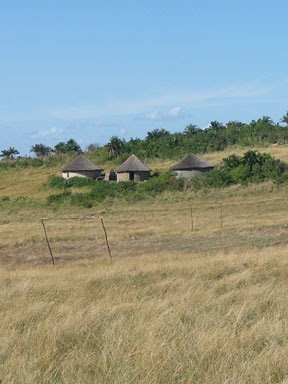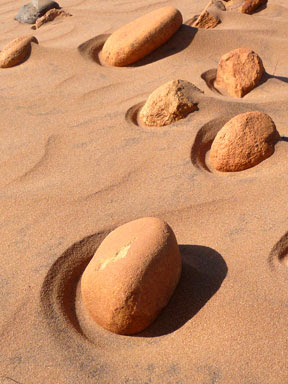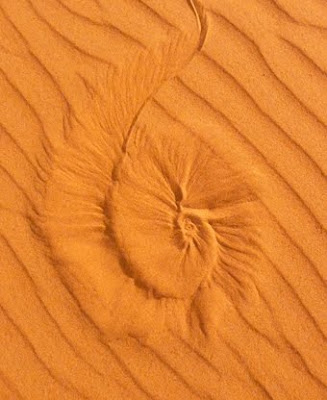Red Dunes of Xolobeni – The curse of the black dirt

My journey started from the Wild Coast Sun Casino. Meeting a guide called Benny Mbotho we made our way down to the beach for a 4-day walk along the coastline.

Our first point of interest was Thompson’s Rock. Getting its name from sir Thompson, a missionary who came to the Wild Coast in 1846. He used the rock and the beach as his classroom. In the afternoons old and young people would come and listen to him. He would then draw in the sand to teach them how to read and write.

This particular stretch of coastline is renowned for having the highest concentration of fossils on the Wild Coast. Benny explained that the formation of Mzamba Riverbed fossils was a very rare and special process, with many factors involved in turning these once living organisms to stone.

It is thought that only the trees that lay directly along the sun’s exact path from East to West were petrified. As all the trees of this "petrified forest" lie the same way, the theory seems to hold true.

Detail of “eye” in petrified tree
Ammonites, Nautilus, Giant Clam and Triangola Shepstonia shells are found here in their thousands. Some fossils are exposed providing a fascinating opportunity for photographs. It is important to note that many of the fossils are only visible at low tide.

These fossils help to demonstrate the movement of tectonic plates as they link up with fossils found elsewhere in India, Madagascar and Australia। They can be carbon dated giving an amazing perspective of the history of the area and the creatures which once called it home. They are estimated to be 84-86 million years old!
Found by Mr Flynn in 1824, these fossils triggered more interest in the area, and soon the discovery of the skeleton of what came to be called a “Mosasaur” led to three more dinosaurs of the Cretaceous period being found. On display at the Albany Museum in Grahamstown- the Mosasaur was a 15 metre fearsome combination of half crocodile, half shark! A sea monster indeed!
It is because of these fossils that Benny became a guide and therefore an ambassador for the environment. Growing up in the area he would spend much time on the beach and from the age of 7, he was already guiding people to the hidden fossil treasures. Not only did he discover thieves chiselling out the fossils, he was also disturbed by the ignorance of fishermen as they damaged the deposits in search of shellfish for bait. He feels that now he has a responsibility to protect the fossils as his own.

Without a guide it would be very easy to walk straight past these natural wonders.
Benny is a very interesting man; talking softly he shares his wide knowledge freely. Knowing the value of the ecosystem and concerned about its well being, he is a living example of how ecotourism can transform and benefit the individuals of a community.
This is a rare finding of a lightning bolt redefining the form of the mineral deposits.

Further along the beach, we came across the “White Man’s House”. This is a series of caves that sit precariously close to the breaking waves on the shoreline. They were used by the survivors of the Grosvener shipwreck of 1782, who stayed for about a year before moving further up the coast. The caves are beautiful, dripping with the spring water that flows over them. It is said that a mythical snake guards the hill from where the water flows, overseeing the dead and keeping the water pure.

It is here that Benny pointed out the black streaks in the beach sand. “ This is Titanium,” he said, with more than a hint of loathing in his voice.
 He began to explain how this black dirt had been a curse on the land.
He began to explain how this black dirt had been a curse on the land.I knew why, as it was the underlying focus of my journey.

Australian-listed Mineral Commodities Limited (MRC) through its South African subsidiary, Transworld Energy and Minerals (SA) (Pty) Ltd. (TEM) had their eyes set on 346 million tons of Titanium in the area between the Mnyameni and Kwanyana rivers. Promising the community positive benefits and rehabilitation of the area after the mining activities, they had proposed this 20-year operation to the Department of Minerals and Energy in 2002.
If any one has been to Richards Bay recently, they would have seen the result of the strip mining process. It is the complete and utter destruction of an ecosystem. While using what water there is from rivers and estuaries, they pump out ground water to run the machines. Absolutely everything is dug up, processed, spat out and flattened, completely destroying the finely balanced habitat of plants, birds and animals. Some species endemic to the area are becoming endangered, not to mention the locals’ houses, crops and cattle grazing areas which would be taken away.

Many mining companies claim that they will rehabilitate the area afterwards, but this is very seldom the case, as they often go insolvent, move along or just carry on mining. This is evident in Johannesburg particularly, from the gold mining, all that is left are large piles of contaminated dead soil and poisoned ground water that future generations and their children will have to deal with.
On their website ( http://www.mrc-res.co.za/home.html ) they claim that mining and tourism can go together. If you are the kind of person who gets excited by destruction, explosions, big holes and Acid rain I suggest a holiday in Middelburg!
There were cases of bribery and intimidation reported within the community, creating tension in this peaceful place. Locals of the region were afraid of losing their land or being forced to leave - some even pre-empted the mining and abandoned their houses altogether. Members of the public became involved, sending out petitions to stop the lease being granted.
A protest walk along the beach from Mzamba to Mnyameni took place last year and was supported by over 1000 people.
 Benny can be seen here third from the left.
Benny can be seen here third from the left.Picture courtesy of http://www.wildcoast.com/xolobeni
For 6 years this debate has been raging, but now the storm has blown over. The DEAT report has advised that “The mining is a short-term economic activity with long-term negative impacts whereas the ecotourism in the area has an unlimited life span,”
It is rumored that the mining company has almost gone insolvent due to investment troubles. With the backlash of the community, passionate stubborn South Africans and the constitution of human rights, a true David versus Goliath battle has been won. And as the dust settles the area known as Xolobeni (place of sadness) has a happier eco conscious future.
For me the most important realisation is that the environment in its natural state has more to offer in the long term than any short-term economic hijacking.
The Amapondo people seem to have made a new start under the ecotourism flag. The locals are friendly, selling their fish and happily guiding or helping in any way they can. They understand that without the land, there are no tourists and without tourists there is no income. The next step is for people like us to support the region by making a plan to use these guides, hotels and backpackers and rejoicing in this beautiful place which once rested on a knife’s edge.
I felt privileged to be here, and on the bank of the Mnyameni River where the protesters had once stood, we made camp and settled down for a night of stars and fireside tales.

In the morning we were greeted with a beautiful sunrise…

Walking inland, Benny took me to see a Sangoma.
This is an experience I had long awaited.
Her title is Amakhosi Nkunyeni, she had lost her old name by becoming a Sangoma. Still in training she wore a white shawl and headband as a symbol of purity and protection. Her first bangle was also white for the same reasons. The number of goatskin bangles on her wrists indicated each sacrifice she had made so far. The role of a Sangoma is to heal the sick of the community, to be a conduit of the voices of the ancestors and a protector from evil spirits.

She burnt the herb called Impepho to chase away bad spirits and open the connection with the ancestors। She asked for a silver coin as a blessing to speak further. She then took her traditional weapons and while kneeling, crossed them over her head for even more protection.

Benny translated that she was ready and wanted to know my question। I was momentarily dumbstruck as my mind tried to grasp with the concept of getting an answer to any of the questions I had ever had. I decided to turn the conversation around. Slowly I asked, “ Do the ancestors have anything important to tell me? ”. She laughed and then spoke for a good 5 minutes in Xhosa, which I don’t understand. Eagerly I asked for the translation. Benny said that she had dreamt of my coming the night before and had a vision of dancing with me in her house! And now she wanted to dance. I interpreted that this must mean I was in the right place at the right time, and happily I joined her in dancing, fulfilling the dream.
The sangoma and the ancestors seemed happy. Walking outside the hut into the bright sunlight, I felt as if I had been teleported into a new world. The wind blew softly on my face. Picking up my backpack, I felt re-energised and strangely comforted by the experience.

After this we walked through the rolling hills and wandered through a couple more homesteads. Getting a glimpse of the simple subsistence lifestyle of the Amapondos, it is easy to see that without the rich soil and bountiful water, life here would be much harder.

Getting back to the beach as the sun set, we found a spot on a headland after the Kwanyana River mouth that was very exposed but had the most incredibly panoramic view. On the point there was a large rock, which we later called “iKhwezi Rock ” (meaning star in Xhosa) that sheltered us from the wind as we sat and watched the stars emerge, slowly revealing the Milky Way with such clarity I became entranced, gazing for hours at the beautiful night sky.

With the sunrise we made tea on the driftwood fire and readied ourselves for the return journey back to the Mzamba River.

Along the beach we found the unofficial soccer grounds for the Wild Coast World Cup 2010!


At the mouth of the Kwanyana river we turned west into the Red Dunes of the Lutungulu area- the exact location of the proposed mining site.
Pictures speak more than words when it comes to beauty…

A desert wonder in the middle of rolling grasslands and lush tropical vegetation…

The “Red Dunes” are estimated to be 8000 years old and are indeed a national treasure - a destination for any avid explorer.

Many artefacts and bones of the Iron Age are strewn here along with crazy rocks and mesmerising sand formations.





The dunes hide the titanium under them- can you imagine destroying the land for this?

Walking back to the Mzamba River I noticed something really amazing, I found not one piece of litter, thus cancelling out my need to collect waste materials for transformation artworks. This gave me a chance to find out more about Benny, his story and involvement in the protests against the mining. He is indeed a model ambassador for ecotourism and a great guide… Please contact him directly and he can give you advice, take you to see the fossils or plan a tailored adventure of your own… Benny - 079 198 5975

His wish is that the Red Dunes can become a World Heritage Site so that they may be protected for future generations to enjoy. I too share his vision.


